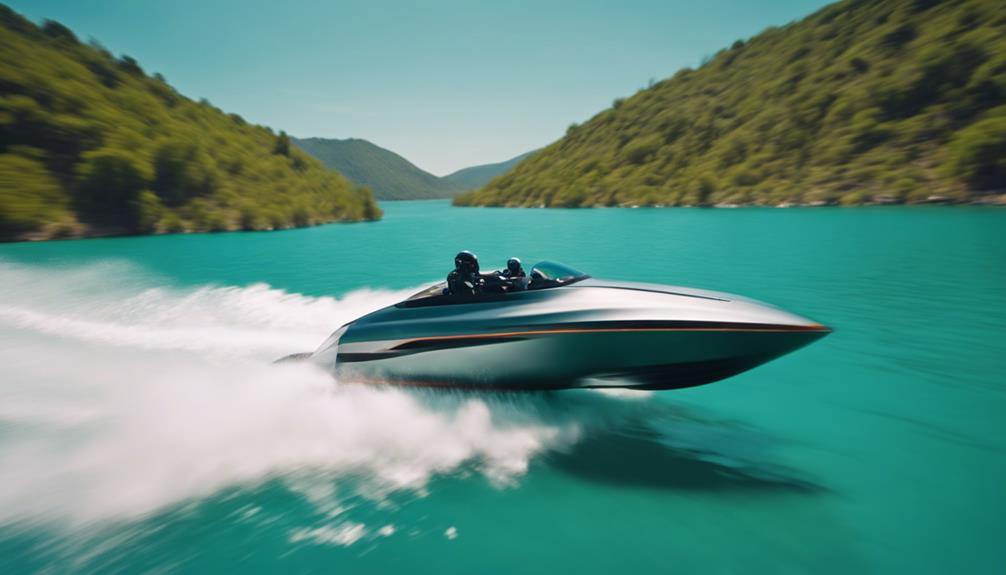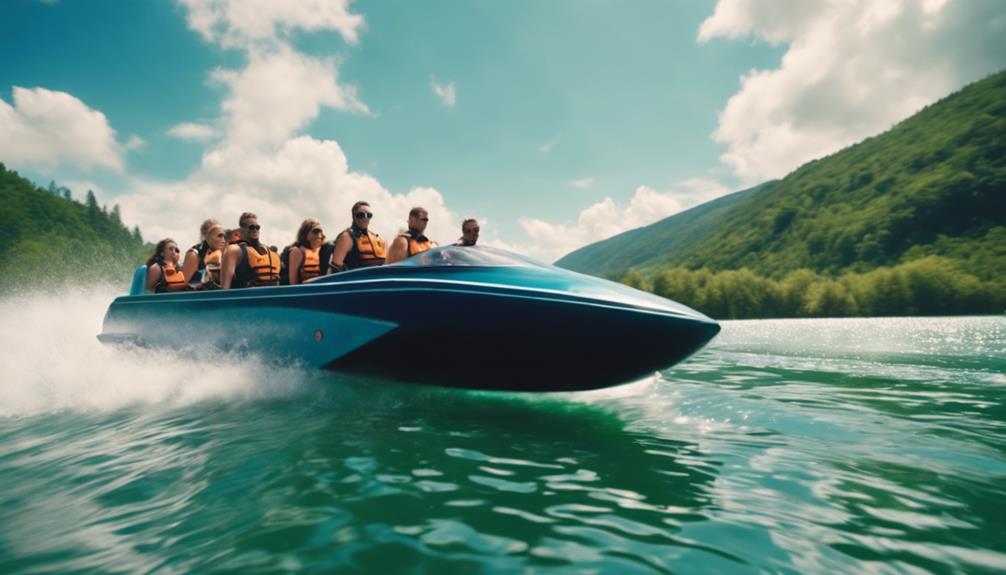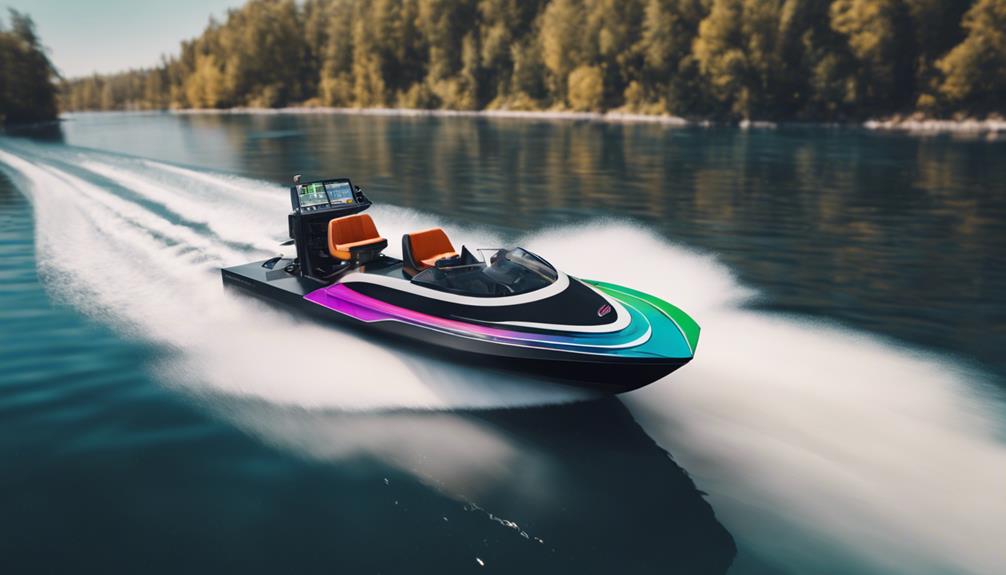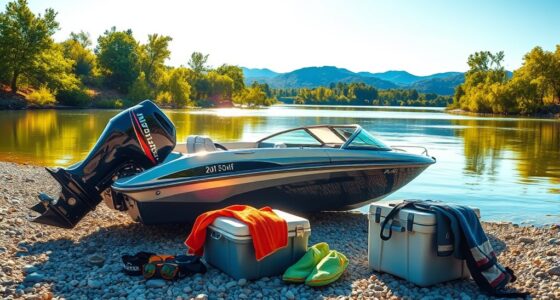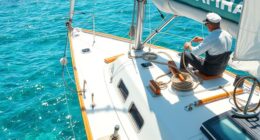A jet boat is a unique watercraft that uses jet propulsion to navigate shallow waters, reaching areas traditional boats can't access—sometimes in just 7.5 cm (3 inches) of water. It works by drawing water through its hull and expelling it to create thrust, making it incredibly maneuverable. Originally developed in the mid-1950s, jet boats have evolved for adventure tourism, emergency rescues, and recreational activities like fishing and racing. They're known for their speed and safety due to the absence of external propellers. If you're curious about their uses and advantages, there's plenty more to explore!
Key Takeaways
- A jet boat is a type of watercraft that uses jet propulsion to navigate shallow waters, allowing access to challenging waterways.
- It operates by drawing water from beneath the hull and expelling it through impellers, creating thrust for movement.
- Jet boats can function in very shallow depths, as low as 7.5 cm (3 inches), making them suitable for rocky or sandy channels.
- They are widely used for recreational activities like fishing, adventure tourism, and rescue operations due to their high maneuverability.
Definition of Jet Boat
A jet boat is a versatile vessel that uses a jet propulsion system to navigate shallow waters by expelling water from the rear. This unique propulsion method allows you to glide over shallow areas where traditional boats might struggle, making jet boats perfect for river adventures and close-to-shore excursions.
Unlike conventional boats that rely on propellers, jet boats have no protruding components below the hull, greatly reducing the risk of damage and enabling smoother navigation through rocky or sandy channels.
The jet propulsion system generates thrust by sucking in water through an intake and pushing it out forcefully at the back, giving you impressive speed and maneuverability, often exceeding 50 mph. This capability makes jet boats ideal for a variety of activities, from fishing and scenic river tours to thrilling adventure sports.
Their design guarantees efficiency and safety, allowing you to explore shallow waters that other vessels can't reach. Overall, a jet boat represents a perfect blend of power and precision, tailored for those seeking both excitement and practicality on the water.
Historical Background
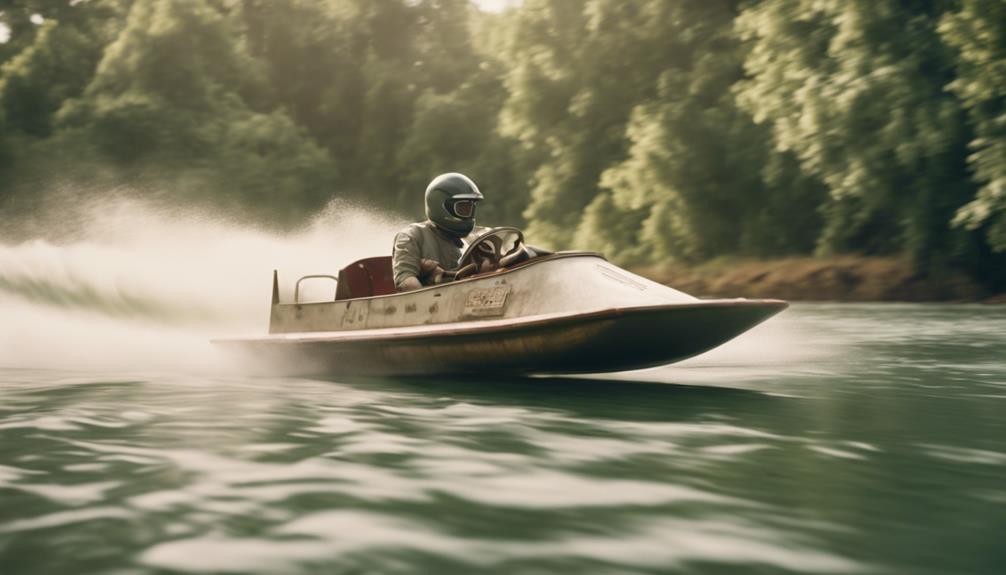
When you look at the history of jet boats, you'll see their origin in the mid-1950s, thanks to Sir William Hamilton in New Zealand.
Over the years, technological advancements have transformed their design and capabilities, making them essential in various sectors.
As you explore their cultural significance, you'll discover how these boats have shaped boating experiences and industries worldwide.
Origin of Jet Boats
Jet boats originated in the mid-1950s, thanks to Sir William Hamilton's innovative design in New Zealand, aimed at tackling the challenges of traversing shallow rivers. This revolutionary jet propulsion system allows boats to operate in waters where traditional propeller-driven vessels would struggle, making it ideal for steering through narrow and shallow waterways. You'll find that the jet boat's unique mechanism works by expelling water through a nozzle, providing enhanced maneuverability and speed.
As jet boating gained popularity, particularly in the 1970s, it transformed recreational activities and adventure tourism. The combination of excitement and accessibility drew many enthusiasts to the sport. With its ability to skim over shallow terrains, the jet boat became a favorite for thrill-seekers and those looking to explore remote areas.
Over the years, the design of jet boats evolved, but the core concept of a boat propelled by jet propulsion remained intact. This innovation not only paved the way for various recreational uses but also found applications in rescue operations and commercial tourism. The impact of jet boats on marine transport is undeniable, creating a lasting legacy in boating history.
Technological Advancements Over Time
Innovations in jet boat technology have profoundly shaped their performance and functionality since their inception in the 1950s. Initially developed by Sir William Hamilton in New Zealand, these powerful jet boats were specially designed to navigate shallow rivers with remarkable agility. Over the decades, advancements in jet propulsion systems have enhanced their efficiency and speed, evolving from older multi-stage models to modern single-stage jets.
In the 1970s, jet boats gained traction for recreational use, thanks to improvements in engine power and hull design. Lightweight materials revolutionized construction, allowing for better acceleration and control, especially in challenging water conditions. Safety features, like reverse thrust systems and enhanced hull designs, have also evolved, greatly reducing the risk of hull strikes in shallow waters.
| Era | Key Advancements |
|---|---|
| 1950s | Introduction of jet boat technology |
| 1970s | Increased popularity for recreation |
| 1980s | Enhanced engine power and hull design |
| 1990s | Lightweight materials introduced |
| 2000s | Advanced safety features developed |
These developments not only improved performance but also made jet boating a safer and more thrilling experience.
Cultural Significance in Boating
The rise of jet boats in the 1970s transformed recreational boating, creating a new era of adventure and excitement that resonated deeply within outdoor culture.
These innovative boats, designed by Sir William Hamilton in the 1950s, allowed you to navigate shallow rivers where traditional propeller boats struggled. With their jet propulsion system, jet boats not only provided high-speed travel but also offered unmatched maneuverability in challenging waterways.
As they gained popularity, jet boats became symbols of freedom and thrill, often featured in adventure tourism and outdoor media. You could experience the rush of gliding over the water, feeling the spray of a jet of water as you raced through breathtaking landscapes.
This cultural significance extended beyond personal enjoyment; jet boats played essential roles in commercial applications like tourism and search and rescue missions.
Today, the influence of jet boats is evident in various high-speed vessels worldwide, showcasing their versatility. They embody a spirit of exploration and adventure, making them a beloved part of modern boating narratives.
Mechanics of Jet Propulsion

When water is drawn from beneath the hull and propelled through impellers, it creates the powerful thrust that enables jet boats to navigate swiftly and efficiently. This jet propulsion system typically employs single-stage jet systems, which are designed for high efficiency and performance, especially in shallow waters.
You'll find that jet boats can operate in water as shallow as 7.5 cm (3 inches), allowing them to access narrow and challenging waterways where traditional propeller boats struggle.
The mechanics involve drawing water in, increasing its velocity via impellers, and ejecting it through a nozzle located at the stern. Steering is accomplished by adjusting the direction of the jet stream, which relies on movable nozzles or deflectors. This means you'll need to keep the engine running for effective control, contributing to the boat's responsiveness.
Thanks to this design, jet boats not only accelerate rapidly but also offer exceptional maneuverability. You can perform quick turns and stops, making them versatile in various water conditions.
Ultimately, the mechanics of jet propulsion empower you to enjoy a thrilling and agile boating experience.
Uses and Applications
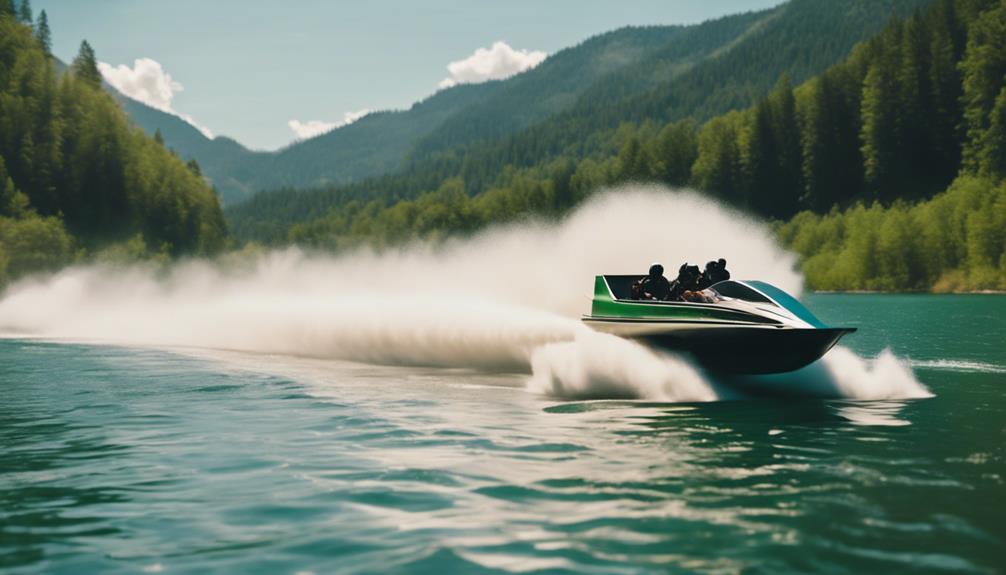
Jet boats open up a world of recreational activities, from fishing to white-water rafting, making your adventures more thrilling.
You can also explore their essential role in adventure tourism, where they provide access to breathtaking landscapes.
Plus, their maneuverability proves indispensable in rescue missions, allowing rapid response in emergencies on waterways.
Recreational Activities Overview
Many people enjoy jet boats for recreational activities, whether it's thrilling river tours, fishing adventures, or steering through challenging waters.
These boats excel in shallow rivers, letting you explore areas where traditional boats can't go. You'll find jet boat tours offer unique sightseeing experiences, allowing you to soak in stunning landscapes and natural beauty.
If you're an angler, jet boats make fishing trips more accessible, enabling you to reach remote spots without hassle. Plus, many tours incorporate exciting elements like bungee jumping or wildlife viewing, giving you an adrenaline rush while you enjoy the scenery.
Jet boats are also a practical choice for outdoor enthusiasts needing quick transportation in hard-to-reach locations, like those on hunting trips. The versatility of jet boats appeals to a wide range of users, from tourists to adventure seekers.
With tour prices typically ranging from $30 to $95 per day, there's an option for everyone. So, whether you're looking for an adventurous day out or a peaceful fishing trip, jet boats offer a fantastic way to experience the great outdoors.
Adventure Tourism Impact
Adventure tourism is thriving with the inclusion of jet boats, which provide exhilarating experiences in stunning natural environments. If you're seeking excitement, jet boat tours offer a unique way to explore nature while enjoying the adrenaline rush of high-speed travel.
Here are four key impacts of jet boats on adventure tourism:
- Access to Remote Areas: Jet boats can navigate shallow and narrow waterways, allowing you to reach remote locations that traditional vessels can't.
- Comprehensive Packages: Many adventure operators combine jet boat rides with activities like fishing, bungee jumping, and wildlife viewing, creating all-in-one experiences.
- Economic Boost: With tour prices ranging from $30 to $95, jet boat experiences are accessible to various tourists, contributing greatly to local economies.
- Enhanced Sightseeing: Jet boats provide opportunities for unique sightseeing, allowing you to witness breathtaking landscapes and wildlife up close.
Rescue and Emergency Uses
Rescue teams frequently rely on jet boats for their rapid acceleration and maneuverability, making them invaluable in emergency situations on challenging waters. These boats can navigate tricky environments quickly, reaching stranded individuals or accessing remote areas during crises. With a shallow draft that allows operation in water as shallow as 7.5 cm (3 inches), they excel in situations where other vessels may struggle.
Equipped with powerful engines, jet boats can hit speeds of up to 50 knots, ensuring swift response times when every second counts. Plus, safety features that eliminate external rotating parts greatly reduce injury risks for both rescuers and victims.
Here's a quick overview of the key benefits of jet boats in rescue operations:
| Feature | Benefit |
|---|---|
| Rapid Acceleration | Quick response to emergencies |
| Shallow Draft | Access to hard-to-reach areas |
| High Speeds | Swift navigation in critical situations |
Jet boats truly stand out in rescue and emergency applications, proving their worth in various environments like rivers, lakes, and coastal areas. Their versatility enhances their effectiveness in diverse rescue scenarios.
Advantages of Jet Boats
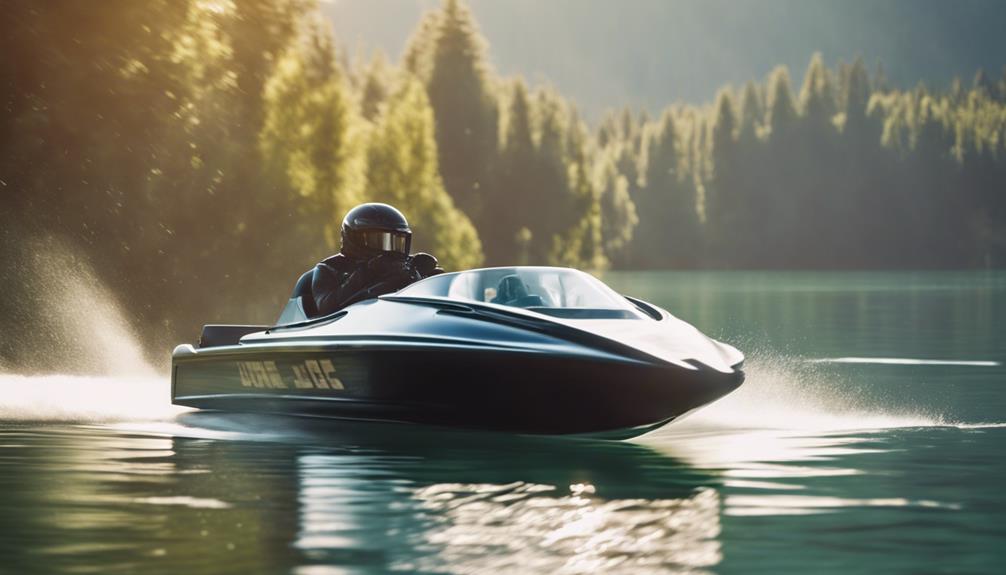
Jet boats offer significant advantages, particularly their ability to traverse extremely shallow waters while maintaining high speeds. This makes them perfect for adventures in tight and shallow waterways where traditional boats can't go.
Here are some key benefits you'll appreciate:
- Shallow Water Traversal: Jet boats can operate in water as shallow as 7.5 cm (3 inches), allowing you to explore areas others can't reach.
- High-Speed Capabilities: With speeds often exceeding 50 knots, jet boats provide rapid transport and quick maneuverability, making them ideal for thrill-seekers.
- Enhanced Safety: The absence of external propellers reduces the risk of injury to swimmers and marine life, ensuring a safer environment for everyone.
- Maneuverability: Jet boats excel in making sharp turns and crash stops, which is beneficial for both adventure tourism and rescue operations.
These advantages make jet boats an excellent choice for those who crave excitement and safety on the water.
Whether you're traversing a narrow river or speeding across a lake, you'll find that jet boats deliver an unmatched boating experience.
Limitations and Challenges

While jet boats offer impressive maneuverability, you'll find that they face notable limitations, particularly regarding fuel efficiency and maintenance.
If the water intake gets blocked, you could see a significant drop in performance.
Plus, keeping up with repairs can be a challenge, especially if you're not familiar with the specific needs of the jet unit.
Fuel Efficiency Issues
Fuel efficiency issues in jet boats often arise from disruptions in water flow, particularly in turbulent conditions or when maneuvering around obstacles. These challenges can lead to increased fuel consumption and reduced performance, impacting your overall experience on the water.
Here are some key factors to reflect upon:
- Intake Blockages: Debris or plastic bags can clog the intake grill, forcing the engine to work harder and consume more fuel.
- Engine Mismatches: If the engine and jet unit aren't properly matched, it can result in suboptimal performance, greatly affecting fuel efficiency.
- Lower Speeds: At slower speeds, the hull resistance increases, which can lead to higher fuel usage and reduced maneuverability.
- Design Limitations: Jet boats can consume up to 35% more fuel than traditional propeller-driven boats at certain speeds due to their unique propulsion method.
Understanding these factors helps you operate your jet boat more efficiently, ultimately saving you money and enhancing your enjoyment on the water.
Maintenance and Repairs
Regular maintenance of your jet boat is essential not only for performance but also for preventing costly repairs down the line. Neglecting maintenance can lead to issues like inefficient fuel consumption and compromised safety.
Here's a quick overview of key maintenance areas:
| Maintenance Task | Importance | Frequency |
|---|---|---|
| Clean Intake Grill | Prevents blockages and improves performance | After each use |
| Engine Compatibility Check | Guarantees efficient fuel consumption | Before upgrades |
| Hull Inspection | Identifies wear and damage | Monthly |
| Safety Feature Checks | Guarantees passenger safety | Before each outing |
| Jet Unit Maintenance | Requires specialized knowledge | Annually |
Due to their unique propulsion systems, jet boats often need mechanics with specialized skills. Traditional boat maintenance methods may not apply, leading to potential challenges. Always verify you're working with someone who understands your jet boat's specifics. By staying on top of these tasks, you can enjoy your jet boat to the fullest while minimizing risks and unexpected costs.
Safety Features and Regulations
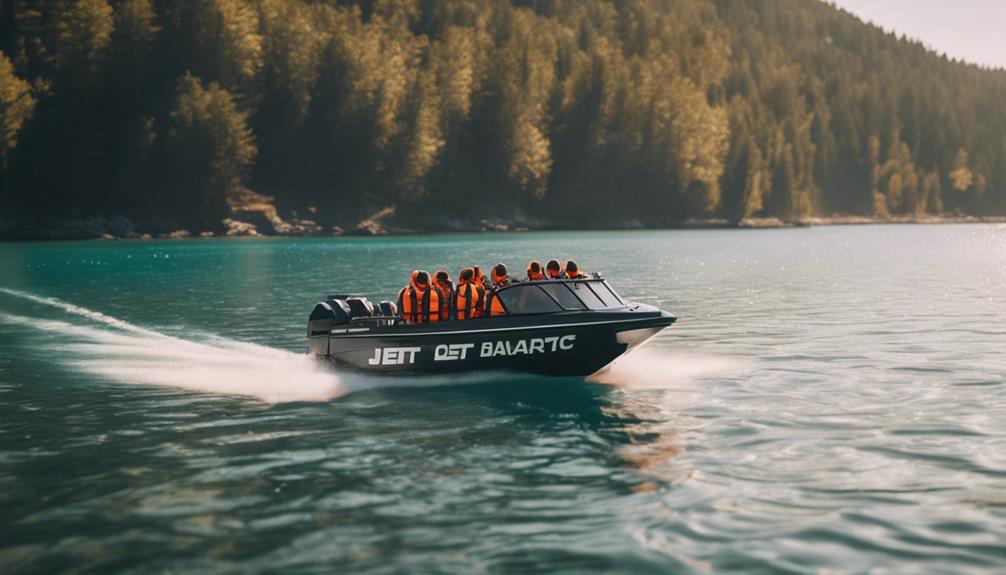
Jet boats offer enhanced safety features, including no external rotating parts, which greatly reduce the risk of injury to swimmers and marine life. When you choose to operate or ride in a jet boat, you'll benefit from a range of safety measures that are designed to protect everyone on board and in the water.
Here are some key safety features and regulations you should know:
- Adherence to Regulations: Operators must follow local maritime regulations, ensuring their equipment meets safety standards.
- Safety Gear: Life jackets and emergency flotation devices are usually provided during jet boat tours, helping to keep passengers safe.
- Regular Maintenance: It's essential to perform regular maintenance checks on jet boat equipment to prevent mechanical failures.
- Operator Training: Jet boat operators receive training to handle high-speed maneuvers and understand emergency procedures for unexpected situations.
Popular Activities With Jet Boats

Many thrill-seekers enjoy popular activities with jet boats, from white-water rafting to scenic excursions. If you're looking for excitement, jet boats offer a range of thrilling experiences that cater to your adventurous spirit. Here are some popular activities you can try:
| Activity | Description |
|---|---|
| White-Water Rafting | Navigate rapid river currents for an adrenaline rush. |
| Fishing Trips | Access shallow waters that traditional boats can't reach. |
| Scenic Excursions | Explore breathtaking landscapes and wildlife. |
| Adventure Tourism | Combine jet boat rides with activities like bungee jumping. |
| Competitive Racing | Experience the speed and maneuverability in events like the World Champion Jet Boat Marathon. |
Jet boats provide a unique way to experience nature, whether you're angling for fish or taking in stunning scenery. You can also seek out adrenaline-pumping combos that elevate your adventure. So, grab your gear and get ready for an unforgettable jet boating experience!
Cultural Significance
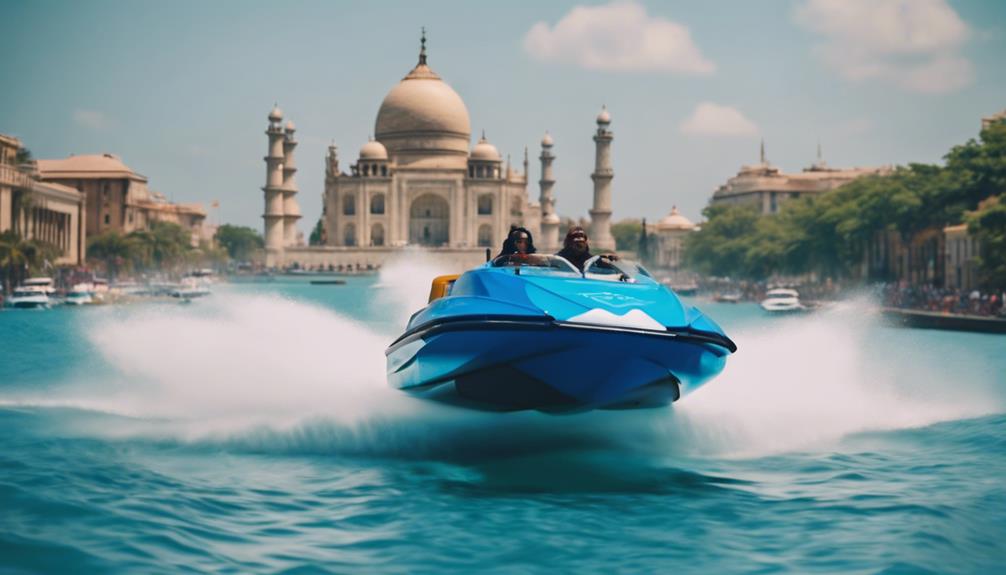
Exploring the thrill of jet boating reveals its deeper cultural significance, as these vessels symbolize freedom and adventure in both literature and modern outdoor experiences. Jet boats have become more than just watercraft; they represent a lifestyle that embraces exploration and excitement.
Here are some key aspects of their cultural impact:
- Literary Symbolism: Jet boats often appear in stories that celebrate the spirit of adventure, highlighting the allure of uncharted waters.
- Tourism Influence: They play an essential role in adventure tourism, attracting thrill-seekers to scenic waterways and boosting local economies.
- Technological Innovation: The shift from traditional propeller-driven boats to jet boats showcases a significant change in boating technology, emphasizing versatility and maneuverability.
- Sustainable Recreation: In various cultures, jet boats facilitate eco-tourism and recreational activities like fishing, promoting sustainable practices in natural environments.
These elements combine to create a rich tapestry of cultural significance surrounding jet boats, making them not just a means of transport but a vehicle for adventure, innovation, and community engagement.
Comparison With Other Watercraft

When comparing jet boats to other watercraft, you'll notice significant differences in propulsion, maneuverability, and suitability for various water conditions. Jet boats utilize a jet propulsion system, allowing them to traverse in shallow waters with drafts as low as 7.5 cm (3 inches). In contrast, traditional boats rely on propellers, which require deeper water to operate safely.
One of the standout features of jet boats is their ability to achieve speeds of up to 50 knots while offering superior maneuverability. They excel in tight spaces and can make rapid stops, making them ideal for recreational activities. Also, since jet boats have no external rotating parts, they minimize the risk of injury to swimmers and marine life, enhancing safety in crowded areas.
However, jet boats aren't without limitations. They're less effective in deep waters where larger vessels can operate more efficiently. Additionally, maintenance can be more complex due to their unique propulsion systems, while traditional boats often have simpler, more accessible designs.
Ultimately, choosing the right watercraft depends on your specific needs and the environments you'll be traversing.
Frequently Asked Questions
What Is the Description of a Jet Boat?
A jet boat's a small vessel powered by water jet propulsion. You'll find it offers high speeds and excellent maneuverability, especially in shallow waters, making it perfect for adventurous navigation and recreational activities.
Why Is It Called a Jet Boat?
It's called a jet boat because, unlike traditional boats with propellers, it uses a powerful jet of water for thrust. This innovative design allows you to navigate shallow waters with speed and agility.
What Is the Theory of Jet Boats?
Jet boats utilize jet propulsion, drawing water in, accelerating it, and expelling it for swift movement. Their design allows you to navigate shallow waters easily while executing sharp turns, showcasing remarkable agility compared to traditional boats.
What Is the Meaning of Jet Ship?
Jet ships, jetting through waters, utilize powerful propulsion systems, allowing you to experience high-speed thrills and sharp turns. These vessels excel in shallow spaces, making them perfect for various adventures and marine maneuvers.
How Does the Definition of a Jet Boat Relate to Its tendency to Porpoise?
The definition of a jet boat porpoising causes explained how this type of watercraft is prone to this issue. Jet boats, with their powerful jet propulsion system, can experience porpoising, a repetitive bouncing motion on the water’s surface. This phenomenon is caused by the interaction between the boat’s hull design and the water flow, often leading to instability.
Conclusion
Just like a swift bird gliding over water, a jet boat harnesses the power of the waves, offering freedom and adventure.
You've explored its definition, mechanics, and unique charm, realizing it's more than just a vessel—it's your ticket to exhilarating journeys.
As you navigate the waterways, remember that each turn and twist mirrors life's own adventures.
So, grab the helm, embrace the thrill, and let the jet boat carry you toward new horizons!

